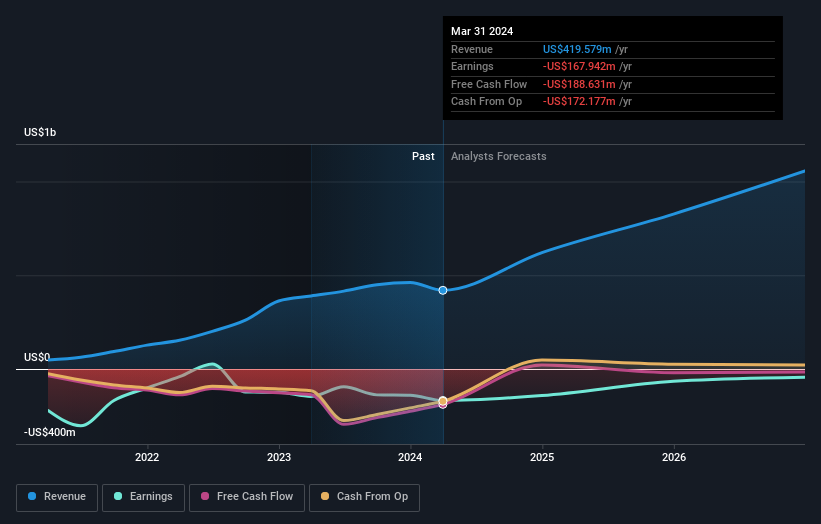Analysts Have Lowered Expectations For Stem, Inc. (NYSE:STEM) After Its Latest Results
The analysts might have been a bit too bullish on Stem, Inc. (NYSE:STEM), given that the company fell short of expectations when it released its first-quarter results last week. It was not a great statutory result, with revenues coming in 59% lower than the analysts predicted. Unsurprisingly, earnings also fell seriously short of forecasts, turning into a per-share loss of US$0.46. The analysts typically update their forecasts at each earnings report, and we can judge from their estimates whether their view of the company has changed or if there are any new concerns to be aware of. We thought readers would find it interesting to see the analysts latest (statutory) post-earnings forecasts for next year.
View our latest analysis for Stem
Following the latest results, Stem's 14 analysts are now forecasting revenues of US$620.6m in 2024. This would be a sizeable 48% improvement in revenue compared to the last 12 months. Losses are expected to be contained, narrowing 15% from last year to US$0.88. Before this earnings announcement, the analysts had been modelling revenues of US$653.8m and losses of US$0.65 per share in 2024. While this year's revenue estimates dropped there was also a massive increase in loss per share expectations, suggesting the consensus has a bit of a mixed view on the stock.
The average price target fell 16% to US$4.02, implicitly signalling that lower earnings per share are a leading indicator for Stem's valuation. There's another way to think about price targets though, and that's to look at the range of price targets put forward by analysts, because a wide range of estimates could suggest a diverse view on possible outcomes for the business. The most optimistic Stem analyst has a price target of US$11.00 per share, while the most pessimistic values it at US$1.50. So we wouldn't be assigning too much credibility to analyst price targets in this case, because there are clearly some widely different views on what kind of performance this business can generate. With this in mind, we wouldn't rely too heavily the consensus price target, as it is just an average and analysts clearly have some deeply divergent views on the business.
These estimates are interesting, but it can be useful to paint some more broad strokes when seeing how forecasts compare, both to the Stem's past performance and to peers in the same industry. We can infer from the latest estimates that forecasts expect a continuation of Stem'shistorical trends, as the 69% annualised revenue growth to the end of 2024 is roughly in line with the 59% annual growth over the past three years. By contrast, our data suggests that other companies (with analyst coverage) in a similar industry are forecast to see their revenues grow 7.7% per year. So it's pretty clear that Stem is forecast to grow substantially faster than its industry.
The Bottom Line
The most important thing to note is the forecast of increased losses next year, suggesting all may not be well at Stem. They also downgraded Stem's revenue estimates, but industry data suggests that it is expected to grow faster than the wider industry. Furthermore, the analysts also cut their price targets, suggesting that the latest news has led to greater pessimism about the intrinsic value of the business.
Keeping that in mind, we still think that the longer term trajectory of the business is much more important for investors to consider. We have forecasts for Stem going out to 2026, and you can see them free on our platform here.
Plus, you should also learn about the 5 warning signs we've spotted with Stem .
Have feedback on this article? Concerned about the content? Get in touch with us directly. Alternatively, email editorial-team (at) simplywallst.com.
This article by Simply Wall St is general in nature. We provide commentary based on historical data and analyst forecasts only using an unbiased methodology and our articles are not intended to be financial advice. It does not constitute a recommendation to buy or sell any stock, and does not take account of your objectives, or your financial situation. We aim to bring you long-term focused analysis driven by fundamental data. Note that our analysis may not factor in the latest price-sensitive company announcements or qualitative material. Simply Wall St has no position in any stocks mentioned.

